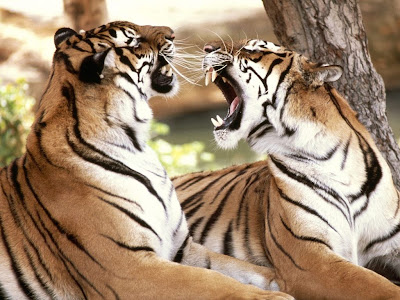Animals Zoo Park |
- Tigers Cub Wallpapers Pictures
- Tigers Video Hunt Photo Pictures From Animals Video Gallery
- African Lions Photos, African Lions Pictures and Animals Info
| Tigers Cub Wallpapers Pictures Posted: 30 Jan 2010 10:08 AM PST |
| Tigers Video Hunt Photo Pictures From Animals Video Gallery Posted: 30 Jan 2010 10:01 AM PST  Tiger Photo Tiger Photo Tiger Hunting Video Pics Tiger Hunting Video Pics Tiger Video Gallery Picture Tiger Video Gallery Picture   How Are Tigers Unique? : Tigers, Panthera tigris, are the biggest cats of all, and they're the only large cats with stripes. Most other members of the feline family are small, weighing 20 kg (44 lb) or less. Only lions and tigers reach weights of 225 kg (500 lb). Once, eight subspecies of tigers roamed the forests of Asia. Now there are only five. Bali, Javan, and Caspian tigers were driven to extinction in just the past 50 years. Growing Up Against the Odds - Danger awaits young tigers at every turn. Even under the best conditions, only 20 percent live to establish their own territories. But tigers are adapted to offset such high natural mortality: Females breed early, deliver cubs after just 103 days, and bear litters of two to four cubs. Tigers Are Built for Predatory Life - Dagger-sharp claws, enormous jaws and teeth, massive forelegs-in an instant, all are in motion to deliver a killing bite. An experienced adult can kill prey four times its size. What Hope for the Tiger? - Mysterious, powerful, majestic--the tiger stands tall in our imaginations. But, in truth, tigers are disappearing in the wild. Just a century ago, an estimated 100,000 tigers inhabited the forests of Asia. Now scarcely 6,000 remain, and soon this magnificent cat may only exist in zoos. Do tigers have a chance? Only if people living near reserves believe that a live tiger is more precious than a dead one. Tigers and Humans: Colliding Worlds - Civilization hems in the tiger. Whole forests have fallen across Asia in the last century, shrinking potential tiger habitat to about 170 small fragments of land in 14 countries. Some pockets contain breeding tigers. But most areas are so small and isolated that if any tigers remain, they probably won't survive. Tigers and Humans: Competing for Resources - The pressing need for food and fuel often pits Asia's human population against the tiger. Where public land is degraded, people slip into reserves to graze animals, collect firewood, and kill the tiger's prey. Poachers have taken thousands of tigers to supply bones and other parts for traditional medicines. Living near reserves takes a toll on people, too. Park animals destroy crops, tigers kill livestock--and, sometimes, people. Scientists: On the Trail of the Tiger - You can't save an endangered animal like the tiger without knowing what it needs to survive. Fortunately, in the last 25 years, four long-term, in-depth studies have revealed much about how tigers interact, what factors shape their lives, and what makes them succeed--or fail--at finding new places to live in the face of declining habitat. Such information is critical to international efforts to save the tiger. Local People: Making Room for Tigers - Many villagers living near Royal Chitwan National Park in Nepal now have a stake in the tiger's future. In 1995, Nepal's legislature passed a law giving half the revenues from protected lands to local development. In addition, part of the park's degraded buffer zone came under local control. With an eye to tourism, villagers fenced off one area and allowed it to regenerate. Gradually, wildlife, including the tiger, recolonized. In 1996 alone, ecotourism revenues from the project built a health unit and three schools. |
| African Lions Photos, African Lions Pictures and Animals Info Posted: 29 Jan 2010 11:01 PM PST African Lions Photo Gallery Pictures and African Lions Information - Animals Zoo Park  African Lion Photo African Lion Photo African Lions African Lions  African Lions Picture African Lions Picture African Lions Info : Lions are unique in that they are the only cats to live in groups (prides). They are the largest member of the cat family and the largest of all the African carnivores. They are are the top predator in any African ecosystem where they live. African Lions Description and Characteristics: Lions are Tawny in colour, varying from silvery yellow to reddish brown with paler undersides (female belly yellowish to almost white); yellow to black mane. Faint, leopard like spots are generally found on the young which is sometimeskept into maturity. Males have thick mane around the head that extend down the chest between the forelegs and varies in colour from blond to black, whereas females do not have manes Lions have massive shoulders and strong forelimbs, long, sharp claws, and short, powerful jaws. A Lions' roar can be heard by humans more than 8 km away. Prides of lions are generally composed of related females, whilst a typical prides contains around 13 lions, large prides can contain as many as 40 lions, while some prides will have a few as two members. A prides home range varies in size from 20-400 km². Lions are mainly nocturnal and are reputed to sleep or rest for about 20 hours a day. You will often find them lying under a shady bush, particularly after they've fed following a kill. African Lions Feeding/drinking Habits: As carnivores, feeding entirely on the flesh of other mammals, lions have 30 teeth, including large piercing canines to grab and kill prey, scissorlike molars to slice into flesh, and small incisors to scrape meat from bones. Much of their hunting is done at night and in the very early dawn. When feeding on a large kill, a lion can eat almost 36 kg of meat in one feeding and then not need to eat for several days. On average, a lion needs to eat about 5 kg of meat daily. African Lion Habitat: The lion is found throughout the south Sahara desert and in parts of southern and eastern Africa. They are generally seen on grassy plains, savannas, and dry woodlands but never seen in heavily forested areas. The lion can be found in most of the National Parks and Reserves in Africa. African Lion Size & Lifespan Males reach up to a shoulder height of 1.2meters and weight between 150-250kgs, females are smaller and reach a shoulder height of 1.05m and weigh up between 120 -180 kgs. Lions live for 12-16 years in the wild and 25 years in captivity. African Lions Reproduction: A lioness has a gestation period of about 110 days, after which she can gives birth to up to four cubs. Generally she gives birth in a secluded areas away from the group and introduces the cubs to the pride when they are about eight weeks old. Very often, several females give birth at about the same time, and they share the duties of protecting and nursing the cubs. Mothers nurse for up to 8 months, although they begin to take cubs to eat at animal kills when they are as young as 3 months old. At about 11 months of age, cubs start learning to hunt with the pride. Females take care of their young until they are about two, when the mother is ready to produce a new litter. Predators and Threats: Although the population of lions is declining, they are not currently listed as endangered or threatened. Threats include hunting, loss of habitat and human encroachment. > Read More African Elephants Information and Pictures - Animals Zoo Park > More African Animals Info and Photos |
| You are subscribed to email updates from Animals Zoo Park To stop receiving these emails, you may unsubscribe now. | Email delivery powered by Google |
| Google Inc., 20 West Kinzie, Chicago IL USA 60610 | |






No comments:
Post a Comment
Note: Only a member of this blog may post a comment.